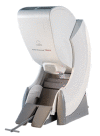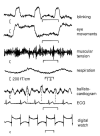A Brief Introduction to Magnetoencephalography (MEG) and Its Clinical Applications
- PMID: 35741673
- PMCID: PMC9221302
- DOI: 10.3390/brainsci12060788
A Brief Introduction to Magnetoencephalography (MEG) and Its Clinical Applications
Abstract
Magnetoencephalography (MEG) plays a pivotal role in the diagnosis of brain disorders. In this review, we have investigated potential MEG applications for analysing brain disorders. The signal-to-noise ratio (SNRMEG = 2.2 db, SNREEG < 1 db) and spatial resolution (SRMEG = 2−3 mm, SREEG = 7−10 mm) is higher for MEG than EEG, thus MEG potentially facilitates accurate monitoring of cortical activity. We found that the direct electrophysiological MEG signals reflected the physiological status of neurological disorders and play a vital role in disease diagnosis. Single-channel connectivity, as well as brain network analysis, using MEG data acquired during resting state and a given task has been used for the diagnosis of neurological disorders such as epilepsy, Alzheimer’s, Parkinsonism, autism, and schizophrenia. The workflow of MEG and its potential applications in the diagnosis of disease and therapeutic planning are also discussed. We forecast that computer-aided algorithms will play a prominent role in the diagnosis and prediction of neurological diseases in the future. The outcome of this narrative review will aid researchers to utilise MEG in diagnostics.
Keywords: brain connectivity; brain network; clinical application; computer-aided algorithms; diagnostic; electrophysiology; magnetoencephalography (MEG); neurological disorder; therapeutic.
Conflict of interest statement
The authors declare no conflict of interest.
Figures









References
-
- Feigin V.L., Nichols E., Alam T., Bannick M.S., Beghi E., Blake N., Culpepper W.J., Dorsey E.R., Elbaz A., Ellenbogen R.G., et al. Global, regional, and national burden of neurological disorders, 1990–2016: A systematic analysis for the Global Burden of Disease Study 2016. Lancet Neurol. 2019;18:459–480. doi: 10.1016/S1474-4422(18)30499-X. - DOI - PMC - PubMed
-
- Kotov S. In: MRI Morphometry of the Brain and Neurological Diseases. InNew Insights into Morphometry Studies. Pares-Casanova P.M., editor. IntechOpen; London, UK: 2017. - DOI
-
- Martins N.R.B., Angelica A., Chakravarthy K., Svidinenko Y., Boehm F.J., Opris I., Lebedev M.A., Swan M., Garan S.A., Rosenfeld J.V., et al. Advances in Clinical Immunology 2021, Medical Microbiology, COVID-19, and Big Data. Jenny Stanford Publishing; Dubai, United Arab Emirates: 2021. Human brain/cloud interface; pp. 485–538.
-
- Hari R., Aina P. MEG-EEG Primer. Oxford University Press; New York, NY, USA: 2017.
Publication types
LinkOut - more resources
Full Text Sources
Miscellaneous

